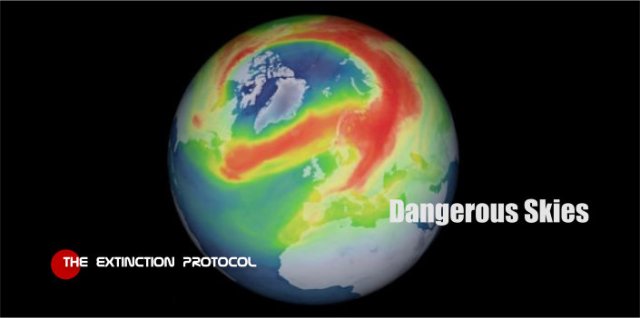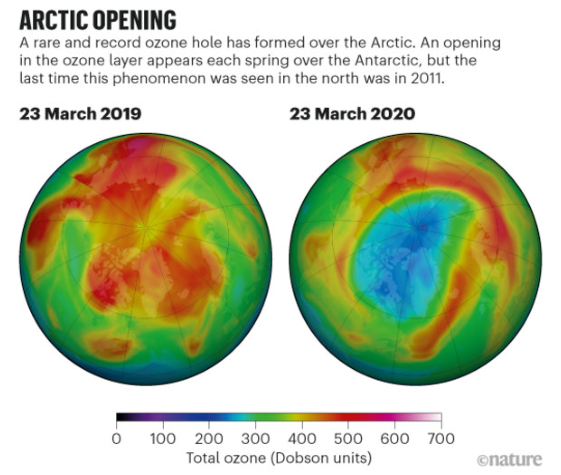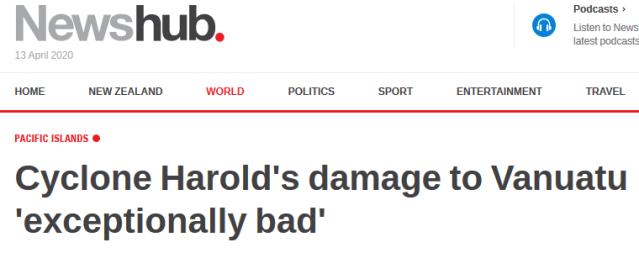
A new hole has opened up in the ozone layer — but it’s not where scientists would expect to find it. The huge hole has been spotted in the Arctic, on the other side of the planet from the infamous hole that forms each year above Antarctica. Scientists from the European Space Agency said this week that this rare hole is the largest of its kind ever recorded over the planet’s northern hemisphere. It covers an area about three times the size of Greenland, according to the journal Nature. “From my point of view, this is the first time you can speak about a real ozone hole in the Arctic, Martin Dameris, an atmospheric scientist at the German Aerospace Center in Oberpfaffenhofen told Nature.

Earth’s atmospheric ozone layer acts as a protective barrier between the sun’s harmful rays and the Earth’s surface. Human-made chemicals called chlorofluorocarbons have been destroying the layer for the past century, causing thinning, and eventually, the massive hole that formed in Antarctica in the 1980s. Experts point to “unusual atmospheric conditions” as the cause of the massive hole, including freezing temperatures that bring high-altitude clouds together. Industrial chemicals interact with these clouds to eat away at the ozone layer. While temperatures consistently plummet in the South Pole each year, these conditions are rare in the North, making ozone depletion much less common.
According to Markus Rex, an atmospheric scientist at the Alfred Wegener Institute in Potsdam, Germany, powerful winds created a polar vortex this year, causing more cold air above the Arctic than in any winter recorded since 1979. Lower temperatures mean high-altitude clouds — and the destruction of the ozone. After signing the Montreal Protocol in 1987, 197 countries agreed to phase out chemicals like chlorofluorocarbons in order to protect the ozone from further damage, which has contributed to a decrease in the size of the hole over Antarctica.
While the newest hole is concerning, scientists say it is expected to heal within the next month as temperatures get warmer. The hole is still nowhere near as worrisome as its southern counterpart and doesn’t currently threaten human health. If it were to drift to lower latitudes in the coming months, Rex said people would just need to be a bit more careful and apply sunscreen to avoid burns. “It wouldn’t be difficult to deal with,” he said. “Right now, we’re just eagerly watching what happens,” says Ross Salawitch, an atmospheric scientist at the University of Maryland in College Park. “The game is not totally over.” In 2018, NASA announced the first direct connection between the ban on chemicals and ozone-hole recovery in the Southern Hemisphere. However, it will still take decades for the layer to repair and the chemicals to completely vanish from the atmosphere. –CBS News

The extent of Cyclone Harold’s damage to Vanuatu is becoming clear after assessment teams were deployed across the island on Monday. But there are concerns any much-needed help with the recovery will be delayed due to the COVID-19 pandemic. The destruction caused by the cyclone is worse than World Vision imagined. “To be honest it is, and that’s not meant to be sensationalistic,” country director in Vanuatu Kendra Gates Derousseau says. She lived through 2015’s Cyclone Pam, which killed at least 15 people and left Vanuatu with hundreds of millions of dollars worth of damage. So, she braced for the worst, but even that fell short. “I’ve really been comparing the damage to a tornado. This almost looks like things have been torn to little pieces. It’s exceptionally bad.”
While the storm may have passed, the reality of the devastation caused is only just starting to register. “A lot of us have certainly been experiencing a bit of post-traumatic stress” Gates Derousseau says. One of the worst affected islands Pentecost reported that 90 percent of dwellings had been destroyed, and a further 20 percent of the population are estimated to be injured. ‘Catastrophic’ is an understatement the Red Cross says, and satellite images show why. Once lush land, it has now been stripped of crops and homes leaving thousands in urgent need of shelter, water and food. “I will say, all the kids and the elderly, they are at risk. Actually, I worry a lot, it’s very very painful,” Jaqueline de Gaillande from Red Cross says. –News Hub NZ

Comments
Post a Comment